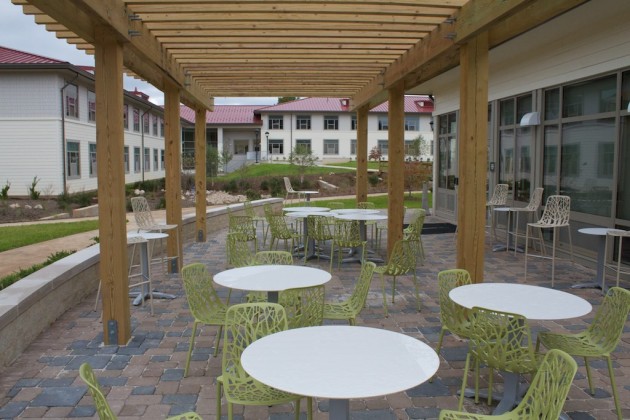The Smithsonian-Mason School of Conservation, a unique program in terms of its academic offerings and contributions to the field of conservation, celebrated the completion of its expansive new academic facilities today, Oct. 18, at the Smithsonian Conservation Biology Institute in Front Royal, Va. This collaboration between SCBI and George Mason University began in 2008 when the program accepted 15 undergraduate students to study at SCBI. Today, the vision and efforts of SCBI and Mason have created a facility that will foster and nurture future generations of conservationists.
“These buildings are living proof of the principles of resource stewardship, sustainability and biodiversity preservation that the Smithsonian-Mason School of Conservation embodies, and they testify to the power of collaboration,” said Smithsonian Secretary Wayne Clough. “The Smithsonian is proud to continue our strong partnership with George Mason University, and the new academic center, residential facility and dining commons will help create tomorrow’s leaders in conservation biology for decades to come.”
With 60 double-occupancy rooms, the new facility can accommodate up to six times more undergraduate, graduate and professional students. It includes teaching laboratories, an atrium, classrooms, offices, a dining facility and exercise room. Architecturally, the facilities themselves embody the spirit of conservation that drives this program. The buildings in the new complex were built to Leadership in Energy and Environmental Design Gold Standard and include features such as geothermal energy, green roofs, a rain garden, wildlife-friendly landscaping and low-flow fixtures reducing the use of water within the entire complex. In addition, SMSC is a “walking campus” with parking only on the outer edges, thus creating a campus with a small carbon footprint.
SMSC offers students from all different fields (biology, wildlife, environmental sciences, journalism, business, etc.) the opportunity to live and work closely with leading experts in the field of conservation. Highly qualified experts, including SCBI scientists, Mason faculty and prominent conservationists from the United States and other countries, provide students with direct connections to the most current teachings, research techniques and work in the field. Moreover, because SCBI is home to more than 20 endangered species, participants in this program have the chance to work with some of the most rare and endangered species on the planet. The students become part of the backbone of groundbreaking research that serves to preserve the diversity of wildlife that surrounds them. The school also offers numerous workshops and community-based training courses and hosts a number of events for other organizations.
The Smithsonian Conservation Biology Institute plays a key role in the Smithsonian’s global efforts to understand and conserve species and train future generations of conservationists. Headquartered in Front Royal, Va., SCBI facilitates and promotes research programs based at Front Royal, the National Zoo in Washington, D.C., and at field research stations and training sites worldwide. (Photos by Brian Gratwicke)







